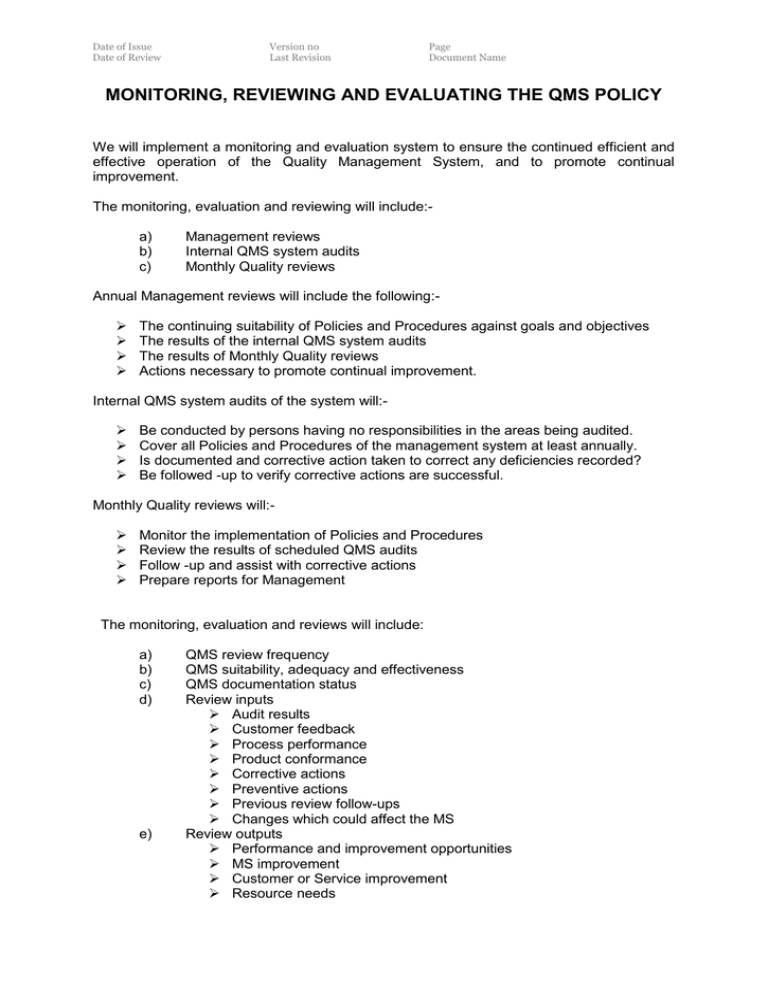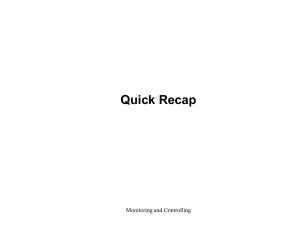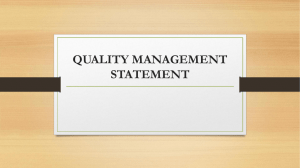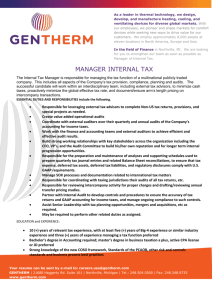Document
advertisement

Date of Issue Date of Review Version no Last Revision Page Document Name MONITORING, REVIEWING AND EVALUATING THE QMS POLICY We will implement a monitoring and evaluation system to ensure the continued efficient and effective operation of the Quality Management System, and to promote continual improvement. The monitoring, evaluation and reviewing will include:a) b) c) Management reviews Internal QMS system audits Monthly Quality reviews Annual Management reviews will include the following: The continuing suitability of Policies and Procedures against goals and objectives The results of the internal QMS system audits The results of Monthly Quality reviews Actions necessary to promote continual improvement. Internal QMS system audits of the system will: Be conducted by persons having no responsibilities in the areas being audited. Cover all Policies and Procedures of the management system at least annually. Is documented and corrective action taken to correct any deficiencies recorded? Be followed -up to verify corrective actions are successful. Monthly Quality reviews will: Monitor the implementation of Policies and Procedures Review the results of scheduled QMS audits Follow -up and assist with corrective actions Prepare reports for Management The monitoring, evaluation and reviews will include: a) b) c) d) e) QMS review frequency QMS suitability, adequacy and effectiveness QMS documentation status Review inputs Audit results Customer feedback Process performance Product conformance Corrective actions Preventive actions Previous review follow-ups Changes which could affect the MS Review outputs Performance and improvement opportunities MS improvement Customer or Service improvement Resource needs Date of Issue Date of Review f) Version no Last Revision Page Document Name Any other business At a minimum, the agenda for the Management review is comprised of the following topics: Mission Statement and Quality Policy Values and Beliefs Follow-up actions from previous management reviews Quality Objectives/Annual Goals and Objectives Customer feedback Results of Audits Status of corrective and preventive action program The preventive maintenance program The calibration program Evaluation of sub-contractors Quality training New employee orientation Overall Quality System Function, including process and product conformance Other changes that could affect the Quality Management System Recommendation for improvement The table below provides an indication of the most important reports that your organization should be using to monitor and evaluate the training and business processes. You can add to the table if the need arises. QMS REVIEW PROCEDURE The purpose of this procedure is to identify actions and responsibilities for conducting and reporting internal audits of the Quality Management System. Internal audits are critical to the success of our Quality Management System. They help to determine the functionality and effectiveness of the system. When the system is not working, internal audits aid in determining if it is because the system needs to be improved or because the documented system is not being followed. Along with corrective actions and management review, audits supply key information to make sound business decisions, and they provide information for continuous improvement opportunities. The results of these audits form an integral part of our management system. Process management and continuous process improvement are fundamental to our quality policy and philosophy, and our approach to auditing reflects this commitment. We focus on two interdependent areas: Auditing the quality management system control and Administrative processes and auditing our key product/service delivery processes. In order to facilitate employee awareness and continuous process improvement, we systematically perform process and sub-system audits, quarterly based on status and importance rather than conduct complete system audits annually. The Management is responsible for scheduling, conducting, reporting, and managing the internal audit process. We audit the QMS to determine the extent to which requirements are fulfilled. We use audit findings to assess the effectiveness of the system and to identify opportunities for Date of Issue Date of Review Version no Last Revision Page Document Name improvement. Our audit process covers both QMS control and administrative processes as well as key product/service delivery processes as previously discussed. The schedule is developed on the basis of status and importance of the activity to be audited and previous audit results. Audits are conducted in accordance with the schedule unless precluded by unforeseen circumstances, in which case the audit will be rescheduled. At a minimum, each element of the Quality System will be audited at least once annually. Audits are coordinated by the Management, and carried out by trained personnel who do not have direct responsibility for the activity being audited. Conducting Audits The internal auditor will notify the leader of the area to be audited at least 3 working days prior to the internal audit. The auditor will develop an audit plan, which includes the documentation to be audited, a checklist of items to review, and sample questions to ask. An entrance briefing will be conducted with the leader of the area being audited to discuss the purpose and requirements of the audit, identify all points of contact, and discuss any other concerns. The audit will be conducted. The audit will include the scheduled subject and any follow up audits required to verify corrective actions from previous audit findings. Although the audit will have a primary focus according to the schedule, any discrepancy relating to the quality system may be investigated. An Internal Audit Record will be documented for each element reviewed, as indicated on the annual audit schedule. These records as well as any checklist used during the conduct of the audit shall be maintained by the management representative to provide objective evidence of audit completion. The completion of an audit will also be indicated on the annual audit schedule by addition of the auditor's initials in the appropriate column. Any audit findings are brought to the attention of the leader with responsibility for the area. Auditor’s documents will identify QMS deficiencies or opportunities for improvement, Corrective/Preventive Action Request, Corrective and Preventive Action. A management representative will record and file all audit findings. The leader responsible for the area audited will take timely corrective action. Time periods for corrective/preventive action are based on the severity and complexity of the discrepancy. Critical findings having a direct impact on the quality of the product must be acted upon within three working days of the Internal Audit Finding Report. The leader of the area and the auditor will agree on completion dates. When corrective action cannot be completed in the agreed time frame, the team leader responsible for the corrective action will contact the audit team leader for assignment of a new due date. Upon completion of each corrective and preventive action, follow-up is conducted to verify implementation and the effectiveness of the corrective or preventive action. Such follow-up action may be conducted as part of a previously scheduled audit, or scheduled independently. Verification results are recorded in the Corrective/preventive action system. If corrective/preventive action was not effective, the finding will remain open and alternate actions planned and implemented until the issue is successfully resolved.






